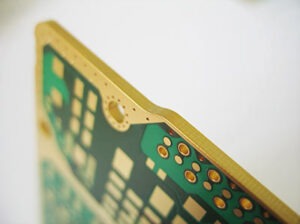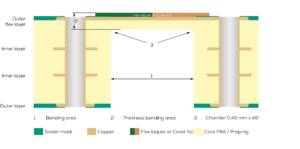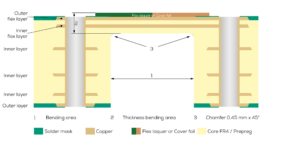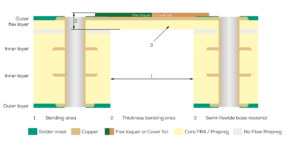Semi-flexible PCBs are suitable for double-sided and multi-layer applications. The semi-flexible structure offers significant cost advantages over classic rigid-flex PCBs and is well suited for static bending stress during assembly and installation.

The Semiflex printed circuit board belongs to the group of 3D printed circuit boards. The technology is suitable for double-sided and multilayer PCBs. The semi-flexible structure also offers significant cost advantages over classic rigid-flex PCBs and is well suited for static bending stress during assembly and installation.
In addition to their attractiveness in terms of price and good static bending stress during assembly and installation, semi-flexible PCBs are characterized by the following parameters:
The manufacturing process of a semi-flexible PCB is simple and is based on the process chain of a standard rigid FR4 PCB. A flexible cover film or a flexible lacquer is applied over the desired bending area instead of the standard solder resist. At the end of the production process, a deep cut is made underneath this area, which reduces the thickness of the PCB in the bending area until the material can be bent without any problems.

Materials | Polyimide / FR4 |
Number of layers | 2-10 |
PCB thickness | 0.6 - 3.2 mm |
End copper | 18, 35, 70 µm |
Ladder structures | Depending on the end copper according to Design Compass |
Smallest drill diameter | 0.20 mm |
Solder resist masks | See general technical specifications |
Surfaces | See general technical specifications |
Contour production | Milling Scoring / retaining bars |
Bending radii | ≥ 5 mm |
Bending angle | ≤ 180° |
Solder resist masks
Additional prints
Edge metallization
In order to improve the EMC protection of a circuit board, to create an electrical contact to the housing of the assembly or to meet increased cleanliness requirements, the front sides of the circuit board contour can be metallized.

Milled vias
It is possible to produce application-specific components with so-called milled through-holes. The resulting circuit boards can be soldered onto another circuit board as components (interposer) due to their front-side contacting option.

Contour processing
Contour production: milling and scoring
Asymmetrical with a copper layer in the flex area (depth-milled)

Asymmetrical with two copper layers in the flex area (depth-milled)

Asymmetrical with a copper layer in the flex area (SF technology)

Between 3D integration and cost pressure - expert tips for cost-efficient 3D printed circuit boards
Are you faced with the challenge of assembling your electronics under difficult installation conditions and still have to adhere to tight budgets? Then three-dimensional PCBs could be your key to success. After all, these space-saving wonders are known for increasing packing density, reducing weight and system costs and increasing the reliability of the assembly. Look forward to a new issue of KSG XPERTS, in which Ralph Fiehler and Sebastian Seifert provide you with valuable tips and tricks for cost-efficient 3D PCBs.
In this online seminar


The smart platform for fast and reliable PCB development.
We have bundled all the parameters for you in our Design Compass.

Talk to us in the early development phases of your project and contact our team of experts. Together we will find the solution that will make your product even better.

With a workshop at our premises or at your site, we give you the opportunity to discuss the key technical aspects and features of your project in detail.

From design and layout checks to various calculations and thermal analyses - the experienced, competent Technical Support team will be happy to help you.